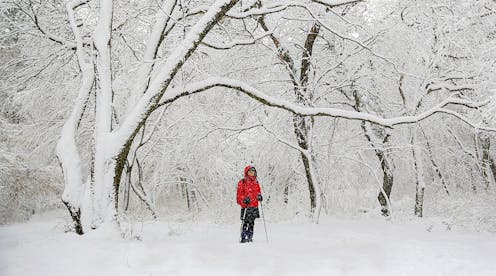In We Do Not Part, Han Kang faces unbearable historical traumas with sorrow and compassion
- Written by Jen Webb, Distinguished Professor of Creative Practice, Faculty of Arts and Design, University of Canberra

It’s daunting to review a novel written by someone who, in 2024, received the Nobel Prize in Literature. The prize was awarded for Han Kang’s “intense poetic prose that confronts historical traumas and exposes the fragility of human life”: a description that applies equally to this newly translated work.
Review: We Do Not Part – Han Kang, translated by E. Yaewon and Paige Aniyah Morris (Hamish Hamilton)
We Do Not Part tells the story of Kyungha, a writer of 20th-century South Korean history, and her longterm friend Inseon, a documentary filmmaker and photographer. Both women are increasingly choosing isolation over the busy professional and social lives they had lived.
Kyungha has pretty much withdrawn from her professional life. She is suffering from depression and anxiety, restless nights and exhausted solitary days. She is losing contact with those she loves.
Inseon had moved from Seoul to the remote island of Jeju several years earlier to care for her ageing mother. After her mother’s death, she chose to remain on the island and switch from screen-based work to furniture-making.
A quest
The novel then enters what can loosely be read as a quest narrative. It is now mid-winter and a wild snowstorm is on the way. Inseon’s home is in a village a long way from the airport, and snow is threatening to shut down the roads.
Nonetheless, Kyungha agrees to take up the quest. She finds herself in an unfamiliar location with a looming frightening weather event and no practical knowledge about how to reach Inseon’s home. As she struggles to reach the destination, she finds herself spiralling like the snow in this winter storm.
There is neither precision or even clarity here: much as the story leaps back through decades, then feels its way back to now, Kyungha stumbles through a landscape that she cannot map and plunges precipitately off the paths. Snowdrifts obscure the roads and “snowflakes resembling a flock of tens of thousands of birds appear like a mirage and sweep over the sea”.
Scratched, bruised and almost frozen, Kyungha finds herself at Inseon’s door, where she is completely isolated: “when I looked back,” she says, “the lone path that bore my deep footprints lay in silence.”
And there she remains, trapped by the weather, haunted by the stories of those she had interviewed for her book on the G– massacre. Stories of running from bullets, bodies being piled up, hiding for years in forests and caves: all the unendurable things that people nonetheless endured.
The wounds of history
The second part of the novel begins with a version of the initial dream of the sea and tree trunks that are metaphors of the dead. Kyungha wakes from this dream to find herself in a sort of ontological uncertainty. Inseon has (impossibly) joined her at the cottage. Kyungha can’t determine whether this is another dream, or if Inseon has died and is visiting her as a spirit, or if she herself has died is only imagining that she is alive and present.
What is not in doubt, though, is the historical record. Kyungha finds that she is not the only person who has been researching state-sanctioned massacres. Inseon, too, has been busy investigating what is known as the April 3rd uprising and the long massacre that followed from 1947 to 1954.
This massacre was organised and undertaken by the US military and the new Republic of Korea, based on the flawed notion that the Jeju islanders were communists. It resulted in the deaths of around 30,000 people.
Nietzsche warned that “if you gaze long enough into an abyss, the abyss will gaze back into you”. Han Kang’s version of this idea is, as she writes in We Do Not Part, that “looking squarely at the injury made it all the more excruciating”.
Here it is Inseon’s nightmares that dominate: this is where her family and people died and where their traces remain. But both women are carriers of nightmare stories. Both stagger under the weight. They have both looked squarely at the excruciating injuries of state-sanctioned murder and they carry the wounds of those histories.
This is an issue Han Kang has been tracing through her novels. Her stories engage, one way or another, with the problem of violence. As she writes in Human Acts, she sees the tendency to “uniform brutality” as something “imprinted in our genetic code”.
But she also notes, in her Nobel Lecture, that we humans “simultaneously stand opposite such overwhelming violence”. Yes, we do terrible things, but we also do generous and compassionate things. We live simultaneously in the scarred world of human history and in the less-damaged natural world.
We Do Not Part portrays massacres and trauma, contrasted with trees and sea water, walks in forests and glorious hymns to snow. It is a novel that depicts a beautiful world, one worth living in, and for. It is a novel that looks, perhaps too squarely, at recent history, while finding consolation in small acts of kindness and community, and in the assurance that, however we understand the phrase, we do not part.
Authors: Jen Webb, Distinguished Professor of Creative Practice, Faculty of Arts and Design, University of Canberra





